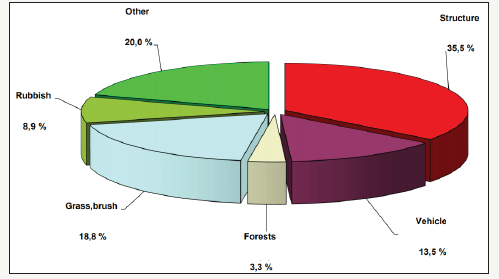- Submissions

Full Text
Advancements in Civil Engineering & Technology
Fires on Buildings: A Needed Study
Cristiano Correa*
Fire Departament Pernambuco, Brazil
*Corresponding author: Cristiano Correa, Body of fire military of pernambuco, Brazil
Submission: June 01, 2018;Published: June 21, 2018

ISSN: 2639-0574 Volume1 Issue3
Introduction
Fires on buildings (comercials, services, factories or residential) are extremely frequent all around the world. It is estimated this type of fire takes around one third (1/3) of all the recorded events. Figure 1 confirms this statement in a study made in thirty-nine (39) countries around the world [1]. The damages that derive from these fires are considerable, specially the economic losses in consequence of the interruption of activities or even productive chains, promoting the “run-out of jobs” [2], over the significant amount of money that are set for the rebuilding process of damaged or even destroyed structures [2,3].
figure 1:Occurrences of fires in the world during the year of 2016 [5].

The United States of America (USA) have recorded 1.6 millions of fires during 2005, with 3,677 deaths, and 83% of these deaths have happened in fires on buildings [4]. Every year hundreds of deaths and billions of dollars in losses of properties happen because of fires [5]. Drysdale [6] says that in The United Kingdom (UK) the amount of direct losses from fire, like physic properties, human lives, and in the production chain, reach more than ₤1 billion pounds and more than 800 deaths every year.
In the USA the financial losses derivate from fires are close to 85 billion dollars, according to Quintiere (1998). Canada has an annual outcome for fires around 11 billion Canadian dollars, based on 1991 and numbers according to Schaenman et al. [7]. Denmark had, during 1998, spends with fires that reach 10.825 million Danish crowns [8]. The cost of fires represents 0.813% of the Gross National Product (GNP) of the USA, 0.864% of the Danish GNP, and 0.729% of the UK GNP, according to Ramachandran [9].
Table 1:Direct Losses and Deaths during Fires [10].

Table 1 presents the outlay with direct losses and deaths because of fires, from 2005 through 2007, according to Geneva Association [10]. Not less evident are the social losses related to fires on buildings that cause, over the temporary of definite unemployment, the eviction of families that have lost their most precious property, their residence. Regarding the social effects of fires [11] takes attention the conflicts and familiar damages derivate from deaths and serious injured. Overall this, the sensation of insecurity and helplessness that gets every viewer of these fires, especially when helped lately or delayed, aren’t taken into consideration in this study.
In this context, the urban agglomeration are part of the geographic layout of Brazil, and other Latin American countries, cities with substantial population densifications, full of natural and specially anthropic risks, causing the increasing of many types of sinister, like: spilling and overflow of dangerous products, car accidents of many modalities, structural collapses, among other undesired events. Among these events, the fires on buildings or built areas deserve special attention. So, the mapping, description of structures, the constitution of burned objects and their heat capability, the regional and local patterns of the fire dynamic, are emergent premises for effectively face the matter [12-14].
References
- Braga, George CB (2008) Investigação de Incêndios. A Segurança Contra Incêndio no Brasil. São Paulo: Projeto Editora, Brasil, pp. 1-484.
- Buchanan AH (2001) Structural design for fire safety. John Wiley & Sons Ltd, University of Canterbury, New Zealand.
- Corrêa, Cristiano (2017) Fire in residence in the City of Recife: An experimental study/Incêndio em compartimento de residência na Cidade do Recife: Um estudo experimental. Revista de la Asociación Latinoamericana de Control de Calidad. Patología y Recuperación de la Construcción 7(3): 2017.
- Corrêa, Cristiano Tiago AP, George CB (2015) Mapeamento de Incêndios em Edificações: Um estudo de caso na cidade do Recife. Revista de Engenharia Civil IMED 2(3): 15-34.
- CTIF, Centre of Fire Statistics (International Association of Fire and Rescue Services) (2018) World Fire Statistics, Report nº22.
- Drysdale D (1998) An introduction to fire dynamics. John Wiley & Sons Ltd, University of Edinburgh, UK.
- Duarte D, Maria do Socorro L, Rosemeri P (2008) Gerenciamento dos Riscos de Incêndio.
- Mcferran K (2011) Music Therapy with Young People in Schools: After the Black Saturday Fires. Voices 11: 2011.
- Moller K (2001) The socio-economic costs of fire in Denmark. Emergency Management Agency, Bikerod, Denmark, USA.
- Oliveira (2013) Tiago Ancelmo de Carvalho Pires de. Fire Resistance of Composite Columns Made of Concrete Filled Circular Hollow Sections and With Restrained Thermal Elongation. Tese de Doutorado, Universidade de Coimbra, Portugal.
- Rachaniotis, Nikos P, Pappis, Costas P (2006) Scheduling fire-fighting tasks using the concept of “deteriorating jobs”. Canadian Journal of Forest Research 36: 652-658.
- Ramachandran G (1998) The Economics of Fire Protection. Routledge, London, UK.
- Schaumann P, Kodur V, Bahr O (1995) Fire behaviour of hollow structural section steel columns filled with high strength concrete. Journal of Constructional Steel Research 65(8-9): 1794-1802.
- Seito, Alexandre I (2008) Fundamentos de Fogoe Incêndio. A Segurança Contra Incêndio no Brasil. São Paulo: Projeto Editora.
© 2018 Cristiano Correa. This is an open access article distributed under the terms of the Creative Commons Attribution License , which permits unrestricted use, distribution, and build upon your work non-commercially.
 a Creative Commons Attribution 4.0 International License. Based on a work at www.crimsonpublishers.com.
Best viewed in
a Creative Commons Attribution 4.0 International License. Based on a work at www.crimsonpublishers.com.
Best viewed in 







.jpg)






























 Editorial Board Registrations
Editorial Board Registrations Submit your Article
Submit your Article Refer a Friend
Refer a Friend Advertise With Us
Advertise With Us
.jpg)






.jpg)














.bmp)
.jpg)
.png)
.jpg)










.jpg)






.png)

.png)



.png)






